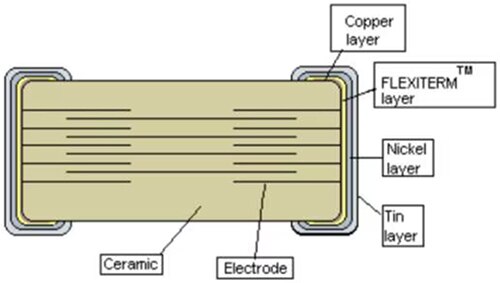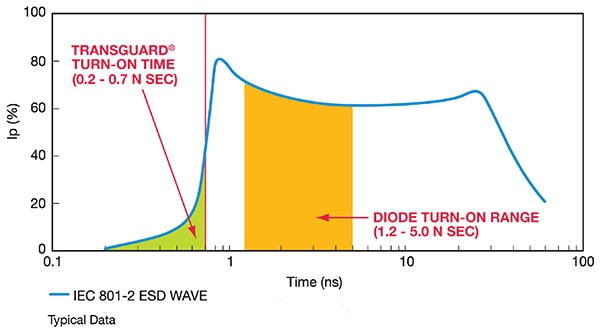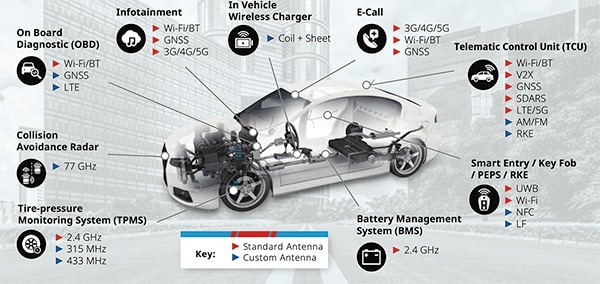Meet Evolving Demands in Automotive Design by Applying Advanced Components
Contributed By DigiKey's North American Editors
2025-06-10
Automotive applications face a complex set of requirements ranging from fundamental needs for high performance, reliability, and safety of electronic subsystems to the growing demand for diverse connectivity options. Meeting these requirements is challenging due to harsh automotive environments, the need for more compact subsystems, and the move to high-voltage electric vehicles (EVs) and hybrids.
Developers require a broad range of capacitors, circuit protection devices, and radio frequency (RF) antennas that can meet or exceed AEC-Q200 standards while satisfying the challenges related to performance, reliability, safety, and connectivity in automotive designs. To overcome these challenges, designers of automotive systems can turn to a company with expertise in Automotive Electronic Council Qualifications 200 (AEC-Q200)-qualified capacitors, circuit-protection devices, and compliant RF antennas. Doing so will save time and increase the likelihood of design success.
This article provides a brief overview of the key trends and design challenges in emerging automotive applications. It then introduces solutions from Kyocera AVX and shows how they can help address those challenges.
How automotive trends are reshaping design requirements
Demand for more features and capabilities has dramatically increased the amount of electronic content in automotive vehicles. Along with more consumer-facing subsystems such as advanced driver-assistance systems (ADAS), embedded electronic subsystems help enhance safety, efficiency, and comfort in both conventionally powered vehicles and EVs. Particularly in EVs, electronic subsystems play a central role in ensuring power and efficiency in the high-voltage powertrains and battery management systems.
Industry trends require developers of conventional and EV automotive electronic subsystems to deliver designs that are more compact and cost-effective, while maintaining the highest levels of performance, reliability, and safety. AEC-Q200-compliant components from Kyocera AVX meet the diverse requirements of the multiple electronic systems necessary to support these emerging trends.
Capacitors support fundamental automotive design requirements
Kyocera AVX’s capacitors support the fundamental requirements for performance, reliability, and safety in automotive electronic subsystems. Built with a variety of technologies, these capacitors provide designers with the necessary combination of rating characteristics, features, packaging, and mounting types, including surface-mount technology (SMT) and radial-lead versions.
Designers often turn to multilayer ceramic chip capacitors (MLCCs), such as Kyocera AVX’s family of AEC-Q200-qualified automotive SMT MLCCs, for applications that require a minimal footprint with high reliability, high capacitance, and low equivalent series resistance (ESR). For example, the KAS21BR72A222JM is an MLCC rated at 2200 picofarads (pF) and 100 volts, and comes in a standard 0805 SMT package measuring 2.01 × 1.25 millimeters (mm).
In the past, conventional MLCCs used in automotive design often failed due to mechanical stress and mismatches between the device's coefficient of thermal expansion and that of the printed circuit board (pc board). Kyocera AVX addresses this issue with its innovative FLEXITERM technology, which incorporates a conductive polymer layer to maintain the electrical connection between the capacitor electrode and termination, even during board flexing, vibration, and thermal expansion. This layer helps reduce common sources of failure without increasing the capacitor’s ESR.
To further protect against failure in safety-critical applications, some Kyocera AVX MLCCs, including the KAS21BR72A222JM, combine FLEXITERM with FLEXISAFE technology. Kyocera AVX’s FLEXISAFE MLCCs (Figure 1) use an internal cascade electrode design to deliver two capacitors in series within a single MLCC package.
 Figure 1: Kyocera AVX’s FLEXITERM MLCC technology incorporates a conductive polymer layer between the electrode and termination to help maintain electrical connection between the device and board despite mechanical stress and thermal mismatch. (Image source: Kyocera AVX)
Figure 1: Kyocera AVX’s FLEXITERM MLCC technology incorporates a conductive polymer layer between the electrode and termination to help maintain electrical connection between the device and board despite mechanical stress and thermal mismatch. (Image source: Kyocera AVX)
With this cascade structure, even if one of the FLEXISAFE MLCC’s internal series capacitors were to be shorted, these devices will maintain their rated capacitance.
Ensuring stable performance in automotive designs
Along with high reliability, many automotive subsystems depend on highly stable, low-loss performance with minimal capacitance change due to temperature, voltage, or aging. For these designs, developers can turn to Kyocera AVX AEC-Q200-qualified C0G (NP0) dielectric capacitors such as the 08051A102J4T2A 1000 pF SMT MLCC, or the AR215A102J4R 1000 pF radial-leaded MLCC.
Built with one of the most stable dielectrics, Kyocera AVX C0G (NP0) dielectric capacitors feature tight tolerances and exhibit excellent stability characteristics, including:
- Negligible capacitance drift or hysteresis: less than ±0.05% compared to as much as ±2% for film capacitors
- Minimal aging effects: typical capacitance change is less than ±0.1% for C0G (NP0), one-fifth that of most other dielectrics (Figure 2, left)
- Minimal capacitance change with temperature: only 0 ±30 parts per million per degree Celsius (°C), less than ±0.3%°C across these devices’ rated temperature range of -55°C to +125°C (Figure 2, right)
 Figure 2: The AEC-Q200-qualified C0G (NP0) dielectric capacitors maintain stable operation with age (left) and across their operating temperature (right). (Image source: Kyocera AVX)
Figure 2: The AEC-Q200-qualified C0G (NP0) dielectric capacitors maintain stable operation with age (left) and across their operating temperature (right). (Image source: Kyocera AVX)
Handling challenging automotive requirements
The emergence of EVs and hybrids has triggered demand for capacitors capable of withstanding the high-voltage environment of these vehicles. Kyocera AVX meets this need with its SkyCap AR Series of AEC-Q200-qualified ceramic capacitors, such as the AR30HC102K4R 1,000 pF radial-leaded capacitor, rated at 3,000 V.
The proliferation of sensors in automotive subsystems necessitates capacitors that can operate reliably in high-temperature environments, such as those found under the hood, in the drivetrain, and on braking systems. The SkyCap AR family members, built with the X8R dielectric, feature an operating temperature range of -55°C to +150°C and offer a wide range of capacitance, as much as 0.33 microfarads (µF) with the AR205F334K4R.
For even higher temperature operation, Kyocera AVX’s THJ series of tantalum capacitors features an operating temperature range of -55°C to +175°C in devices with capacitance extending from 0.1 µF with the THJA104K035RJN to 220 µF with the THJE227K010RJN. The former is manufactured in a standard 1206 (3.2 mm × 1.6 mm) SMT package, and the latter in a standard 2917 (7.3 mm × 4.3 mm) SMT package.
More compact solutions are becoming increasingly important in vehicles. Kyocera AVX integrated passive component (IPC) AEC-Q200-qualified W2A series capacitor arrays provide two or four capacitors in a single 0508 (1.3 mm × 2.1 mm) package. The W3A43C104K4Z2A, part of the company’s IPC AEC-Q200-qualified W3A series capacitor arrays, is a FLEXITERM ceramic IPC capacitor array that integrates four 0.1 µF capacitors in a single 0612 (1.6 mm × 3.2 mm) package. This combination of features provides a compact solution that can withstand mechanical and thermal stress, while offering significant board real estate savings compared to designs using discrete capacitors (Figure 3).
 Figure 3: Manufactured in a 0612 package, a W3A four-element capacitor array, such as the W3A43C104K4Z2A, can withstand mechanical and thermal stress while offering significant board real estate savings. (Image source: Kyocera AVX)
Figure 3: Manufactured in a 0612 package, a W3A four-element capacitor array, such as the W3A43C104K4Z2A, can withstand mechanical and thermal stress while offering significant board real estate savings. (Image source: Kyocera AVX)
The broad array of Kyocera AVX’s AEC-Q200-qualified capacitors satisfies increasingly diverse requirements; however, more advanced, higher-voltage electrical vehicle architectures add requirements for robust circuit protection.
Protecting sensitive electronics in the harsh automotive environment
Kyocera AVX AEC-Q200-qualified TransGuard multilayer varistors are designed to deliver robust protection, providing bidirectional overvoltage protection to safeguard sensitive automotive electronics. They also offer the electromagnetic interference (EMI) and RF interference (RFI) attenuation necessary to mitigate signal distortion and meet regulatory requirements. In providing bidirectional overvoltage protection, these components function similarly to back-to-back zener diodes, but with a response time of less than 1 nanosecond (ns) (Figure 4), allowing them to counter overvoltage events more rapidly.
 Figure 4: Although TransGuard varistors function similarly to back-to-back zener diodes, they exhibit significantly faster turn-on time, ensuring a quick response to overvoltage events. (Image source: Kyocera AVX)
Figure 4: Although TransGuard varistors function similarly to back-to-back zener diodes, they exhibit significantly faster turn-on time, ensuring a quick response to overvoltage events. (Image source: Kyocera AVX)
The TransGuard family members meet a broad set of performance requirements for high reliability, high current handling, and high energy absorption. For many lower-energy applications, such as sensor system protection, the VCAS040205X150WP offers an effective solution with its 5.6 volt direct current (VDC) working voltage, 18 volt clamping voltage, and 20 ampere (A) surge current across an operating temperature of -55°C to +125°C. For high-energy, high-temperature applications under the hood and elsewhere, the VGAH322026Z570DP meets requirements with its 1.8 kiloampere (kA) surge current and 13 joule (J) energy ratings across an operating range of +55°C to +150°C. The TransGuard FLEXITERM series provides devices with a similar broad range of protection characteristics, along with robust protection against mechanical stress and thermal mismatch.
To help developers protect automotive circuits in temperature-sensitive applications or high-temperature locations, Kyocera AVX’s AEC-Q200-qualified negative temperature coefficient (NTC) thermistor family supports a wide range of performance and manufacturing requirements through multiple series, including:
- NB Series, comprising SMT thermistors for lead-free soldering
- NC Series, comprising SMT thermistors for hybrid assembly
- ND03 Series and NJ28 Series, composed of leaded thermistors
For highly accurate temperature sensing, family members such as the NJ28PA0203F-- leaded thermistor provide the required tight tolerance and steep resistance changes with temperature. For temperature control or compensation applications, components such as the NC20R00105JBA can provide the necessary stable sensing over a wide temperature range.
Enabling the connected vehicle
As wireless connectivity between and within vehicles becomes increasingly essential, Kyocera AVX’s A Series RF antennas meet the emerging requirements for multiple connectivity technologies and bandwidths (Figure 5).
 Figure 5: The A Series RF antennas provide a standard solution for the growing demand for diverse connectivity options across multiple automotive subsystems. (Image source: Kyocera AVX)
Figure 5: The A Series RF antennas provide a standard solution for the growing demand for diverse connectivity options across multiple automotive subsystems. (Image source: Kyocera AVX)
Designed for easy implementation and fast time-to-market, these antennas support the leading connectivity technologies for personal communications, data networking, safety systems, and navigation with devices including the following:
- AP822601 broadband antenna for cellular, Wi-Fi, and industrial, scientific, and medical (ISM) connectivity
- A9002137 global navigation satellite system (GNSS) antenna supporting the most commonly used frequencies for personal and commercial navigation
- A9001978 antenna for dual-band Wi-Fi, Bluetooth, or ultra-wideband (UWB) connectivity
Although the AEC-Q200 standard does not explicitly cover antenna products, the A Series RF antennas are rigorously tested, following the requirements and procedures outlined in the standard, to provide developers with the level of reliability and performance required for automotive systems.
Conclusion
As the automotive industry rapidly advances toward vehicles with higher electronic content, designers require components that deliver greater performance, reliability, safety, and connectivity in increasingly compact and demanding environments. Kyocera AVX helps meet these challenges with a broad range of AEC-Q200-compliant capacitors, circuit-protection devices, and RF antennas.

Disclaimer: The opinions, beliefs, and viewpoints expressed by the various authors and/or forum participants on this website do not necessarily reflect the opinions, beliefs, and viewpoints of DigiKey or official policies of DigiKey.









